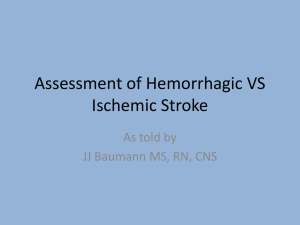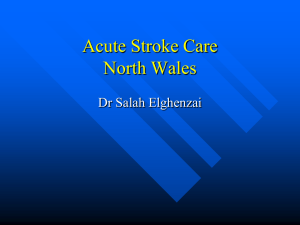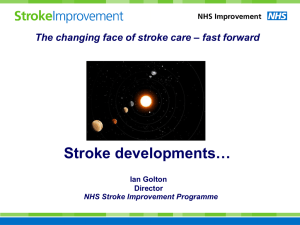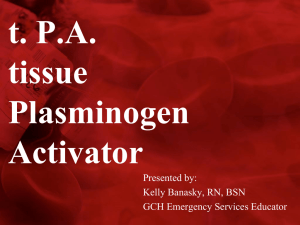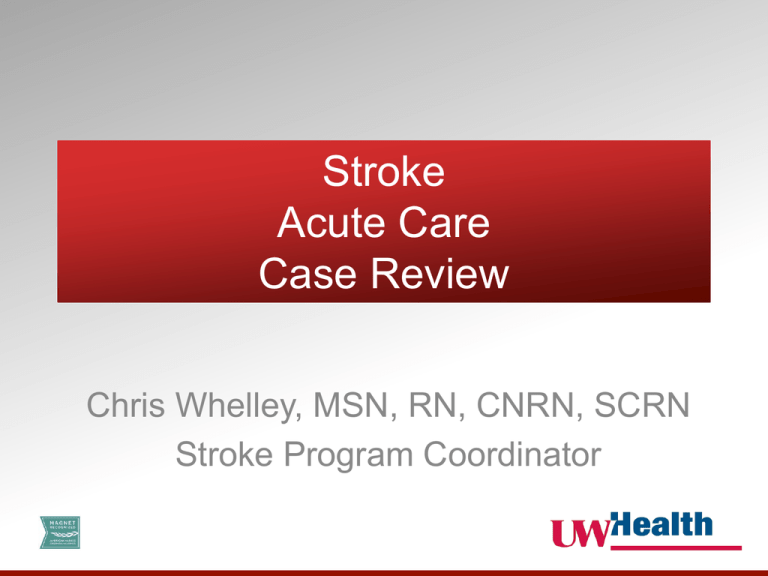
Stroke
Acute Care
Case Review
Chris Whelley, MSN, RN, CNRN, SCRN
Stroke Program Coordinator
Outline
•
•
•
•
•
Acute stroke clarification
Evolution of acute treatment
Case
EMS best practice
What’s to expect in the next two years
Acute Stroke
What is included?
• TIA?
• Wake up stroke?
• Stroke from last week?
IV Thrombolysis History
• 1995 NINDS tPA study published
• 1996 FDA approval of Alteplase for stroke up to 3
½ hrs from stroke symptom onset
• 2008 European Cooperative Acute Stroke Study
(ECASS)-3
• 2008 Safe Implementation of Thrombolysis in
Stroke- Monitoring Study (SITS MOST) provided
data
• 2009 AHA Guideline for treatment with IV tPA up
to 4 ½ hrs from onset
Access Center
Note Time: 1/1/13 0836
•
•
•
•
•
•
•
LKN 6 am, OSH 7:11
Aphasic
Right facial droop, Right arm/leg weakness
15 weeks pregnant
104/58, Plt 279, K 2.7
CT shows ischemic stroke
tPA candidate but no data on safety to fetus.
Family aware and very concerned about patient
• tPA to be administered with immediate transfer
via ground
09:13 report to ED
• LKW at 0600 by husband, speech slurred @ 0615, HA x
3 wks
• 0835--GCS--15, no able to hold up neck, can't stick out
tongue
• Able to obey commands on left---no movement on right,
not able to speak, stick out tongue
• Able to shake yes/no
• 110/57, 85, 16, 98%, 97.3 A; K+--2.7, KCl started
• Husband coming in ambulance
• TPA infusing per right IV--4.491 @ 0847
On arrival to UW
• 15 weeks pregnant and per report has been having new
headaches for several weeks
• otherwise healthy with no prior history of neurological
disease
• NKDA
• Pre-Stroke Rankin Score: 0 - No symptoms at all
• Lives with husband
• Family History: Patient cannot provide
• Review of Systems: Patient cannot participate
Physical Exam
09:55
• BP 116/65 | Resp 16 | Wt 49.89 kg (110 lb) | SpO2 100%
• General Appearance: Glassy stare
• Neurological Examination: Total NIHSS Score: 24
• Mental Status: Awake, eyes open, can look toward
voices but appears altered, can follow commands with
eyes but otherwise does not follow commands.
• No speech. No obvious neglect or gaze deviation.
PE continued
• Cranial Nerves: PERRL, vertical eye movements intact,
does not blink to threat from either side, no facial
asymmetry but appears bilaterally weak.
• Motor: Low tone in right arm. Allows right arm and leg to
fall to bed with no antigravity strength, left arm and leg fall
to bed more slowly. No spontaneous movements.
• Reflexes: Extensor plantar response on left, flexor on
right
• Sensory: Triple flexion bilaterally to noxious stimuli, less
brisk on right
Diagnostic Testing
• Imaging: CT from OSH no hemorrhage or early signs of
ischemia
• CTA with occlusive basilar thrombosis, areas of
hypodensity in left cerebellum
• ECG: Sinus
• Laboratory Results: K from OSH 2.7
• CBC with WBC 10.9, Hgb 13.6, Plt 279, INR 0.9
Assessment
• Ms. Smith is a young woman presenting with acute onset slurred
speech and right-sided weakness progressing to muteness and
quadriparesis. Her neurological exam at present is remarkable for
deficits referable to the bilateral corticospinal and corticobulbar tracts.
Her ability to follow commands with her eyes is concerning for
progression to locked-in syndrome. STAT CTA revealed a basilar
occlusion. Given her severe deficits and failure to improve with tPA
she was taken immediately to the endovascular suite. This was
discussed with her husband, who was present and consented to the
procedure. Given the severity of her symptoms it is appropriate to
proceed with care despite potential harm to the fetus. We appreciate
rapid response and management of our neurosurgical colleagues.
The etiology of this stroke may be dissection, possibly related to
hyperemesis, vs embolic from pregnancy hypercoagulability. We will
of course continue to follow her during her hospital stay.
Plan
• Was tPA Administered?: Yes - at the referring hospital
• IV tPA bolus date:
• IV tPA bolus time: 0847
- Endovascular intervention for basilar thrombosis.
- Post-intervention management per Neurosurgery.
- Intermittent telemetry, lipid panel, Hgb A1c for stroke evaluation
• Consult OB when she is stabilized to discuss pregnancy.
• Stroke will continue to follow, please call with any questions or
concerns.
• Patient examined with and plan per attending Dr. Bradbury.
Brief Operative Note
Diagnosis: Basilar artery thrombosis
Procedure: Vertebrobasilar angiogram with mechanical
thrombectomy of basilar artery thrombosis and eventual
recanalization with stent placement
Findings:
• 1. Basilar artery thrombosis.
• 2. TICI III recanalization using Solitaire device with
immediate rethrombosis with two attempts.
• 3. Enterprise stent placement within the basilar artery
with eventual TICI III recanalization.
Next morning
“…is doing extremely well this morning. She
was extubated yesterday evening. She has
no problems with speaking, moving her
extremities or vision. She is feeling
generally well overall and ‘much better’ than
yesterday”
Neuro exam: no singificant focal deficits
MRI confirms only small areas of diffussion
restriction in the right cerebellum.
Speech Language Pathology
day #2
• Clinical Impression: female admitted for basilar
thrombosis s/p tPA, endovascular
thrombectomy, and stent placement. Patient
currently presents with grossly functional
cognitive-linguistic skills. Patient's speech and
language were intact. No further services
indicated at this time.
• Expected Disposition: Home with no ongoing
Speech Language services
Physical Therapy
day #2
• Assessment: Patient doing very well with gait
and balance today. She appears more confident
today and does not demonstrate any gait
deviations . Balance appears normal as well. Pt.
Is safe for d/c home when medically ready and
has no ongoing PT needs at this time.
• Recommended Disposition: Home with no
further Physical Therapy recommended at this
time
• Plan: Discharge from Acute Physical Therapy
Occupational Therapy
day # 2
• Clinical Impression: female admitted for new onset stroke.
Patient currently presents with some generalized weaknesslikely secondary deconditioning/pregnancy fatigue- which is
symmetrical. Also with some mild decreased hand
coordination bilaterally which may have an effect on handling
dental tools. She is presently doing well with basic self cares
and will have good support at home. She was educated in
Home Exercise Program and appears to understand well.
MVPT was also 1 point below norms, but this appears to be
secondary her rushing with her answers. Encouraged her to
slow down for improved success. No further OT needs
identified at this time, but will continue to monitor he status
until discharge for any status changes.
OB
Fetal heart rate normal
Ultrasound indicates normal movement of
fetus
Questions?
2007 AHA Guidelines
Strategies for EMS in stroke systems
• Rapid access to EMS, 911 universal
• EMS (responders, dispatchers) trained to
recognize and respond
• Collaboration of EMS, ED, Stroke Team
• Track data, improve feedback to EMS
• Advocate for state wide plan for EMS
protocols
Recommended parameters
• 100% of dispatch use high-priority EMS
response at highest level available
• Receipt of call and dispatch less than 90
seconds for 90% of calls
• EMS communicators correctly ID a
maximum percentage of callers
experiencing stroke and dispatch EMS
responders at the highest priority
Recommendations p.2
• 100% of EMSs use validated prehospital
stroke scale
• Ensure screeners over-identify stroke
• To provide continuous quality improvement
stroke screening assessments should be
compared against final diagnosis
Goals for response time
• EMSS less than 9 minutes 90% of time
• Dispatch < 1 minute
• Turnout < 1 minute
• Travel time equivalent to trauma and AMI
• On scene time < 15 minutes
Ensure pre-arrival notification
• Measured for EMS
• Measured for Primary Stroke Centers
• Measured for Comprehensive Stroke
Center
Develop Stroke System Transport
Protocols
• Paul Coverdell Federal Grant Recipient
• State Wide Map
• State wide regional meetings
• Milwaukee and others
• October 29th 3-hospital event in Madison
2013 AHA Guidelines
•
•
•
•
Public stroke education
Chain of survival (again )
Lot’s of repetition of previous
Intra arterial fibrinolysis can be considered
in post op stroke patients
• Combination IV, IA may be considered
• Mechanical clot disruption (Merci,
Penumbra, Solitaire, Trevo)
Acute Stroke Ready Hospital
• New designation coming
• Small hospitals with 24/7 CT capability
• Able to administer tPA quickly with access
to stroke experts likely via Telestroke
Cincinnati and other communities
• EMS stroke team
• Portable CT scanner
• Doc on rig with EMS
• tPA in hand
Questions?


